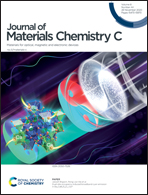Particularly developed transition from the 5D1 level of Eu3+ and its significant contribution to the improved photocatalysis of (Bi3Li)O4Cl2via prolonging the decay time of the excited state†
Abstract
There is a close correlation between the photoluminescence and photocatalysis of a semiconductor because the two processes involve the same electronic transition. Eu3+ is one of the most popular rare-earth ions; it presents efficient luminescence and improved photocatalysis. Usually, the luminescence from the higher states (5D1,2) of Eu3+ can be hardly observed due to cross-relaxation processes. This work demonstrates a particularly developed transition from the 5D1 level of Eu3+ and its significant contribution to the improved photocatalysis of (Bi3Li)O4Cl2via prolonging the decay time of the excited state. Single-phase (Bi3−3xEu3xLi)O4Cl2 (x = 0, 0.01, 0.03, 0.05) was synthesized by the sol–gel method in combination with a solid-state reaction. This is a bismuth layer structure with [(Bi/Li)O2]2+ layers formed by alternative Bi3+ and Li+ stripes. The intrinsic luminescence of (Bi3Li)O4Cl2 (λem = 500 nm) with a decay time of 0.26 μs was detected even at 300 K. Unusually, the phosphor shows a prominent transition from 5D1 in (Bi3−3xEu3xLi)O4Cl2. Moreover, in addition to 5D0 → 7F3, 5D0 → 7FJ (J = 0, 1, 2, 4) is characterized by intense transitions with comparable intensities. The intrinsic emission of (Bi3Li)O4Cl2 has a decay time which involves the band transition of an electron from the valence band to the conduction band. In Eu3+-doped (Bi3Li)O4Cl2, there are midgap states formed by the 5D1 level with a longer lifetime of about 60 μs. The D1 levels of Eu3+ significantly contribute to the separation of light-induced charges by prolonging the decay time of the excited states. This work demonstrates a simple strategy to develop optical materials with simultaneous luminescence and has improved the photocatalysis in bismuth oxychlorides featuring strong polarization and rigid phonons.



 Please wait while we load your content...
Please wait while we load your content...